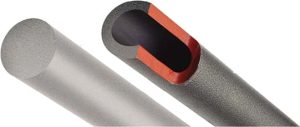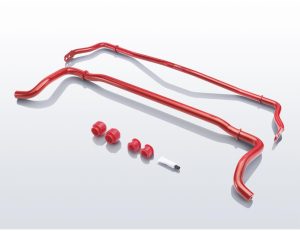Upgrading a vehicle’s stabilizer bar (aka sway bar, anti-roll bar) is a common modification to improve handling, reduce body roll, and sharpen cornering balance. Yet one frequently debated decision is whether to use a solid steel bar or a hollow (tubular) bar. Both have advantages and trade-offs. The choice affects stiffness, weight, durability, cost, and suitability for certain driving conditions.
In this article, we’ll compare hollow and solid stabilizer bars in detail, examining their respective pros and cons, real-world use cases, and how to choose the right one for your setup.

Basics of Torsional Stiffness
Before comparing hollow vs. solid bars, it helps to understand how a sway bar resists twisting (torsion). The torsional stiffness kk of a circular cross-section bar (solid or tubular) is proportional to:
-
The shear modulus of the material (G)
-
The polar moment of inertia of the cross section (J)
-
Inversely proportional to the length between ends
Because of the fourth power dependence on radius, a hollow bar with a larger outer diameter can match or exceed the stiffness of a smaller solid bar while using less material in the core. In effect, much of the torsional load is carried near the outer surface of the cross section.
As demonstrated in strength testing, hollow (tubular) sway bars can outperform solid bars of equivalent stiffness while saving weight.
Pros and Cons: Hollow vs Solid
Here is a side-by-side comparison:
| Feature | Hollow Stabilizer Bar | Solid Stabilizer Bar |
|---|---|---|
| Weight | Lighter for equivalent stiffness, improves unsprung mass and balance | Heavier — all mass contributes |
| Stiffness per unit weight | Very good — can be optimized via wall thickness and outer diameter | Less efficient — solid material adds weight |
| Durability / Strength | Requires careful manufacturing and sufficient wall thickness; risk of fatigue or cracking if underspecified | Simple, robust, less sensitive to defects or thin spots |
| Manufacturing cost | Generally more complex; bending, wall quality, welding add cost | Easier to manufacture, more forgiving |
| Cost | More expensive at high quality | Usually cheaper, easier to produce |
| Performance flexibility | Allows larger diameter with lower mass, better tuning possibilities | Limited by weight concerns |
| Failure mode | May crack or fatigue at wall or welds | Likely to yield or bend but less prone to catastrophic fracture |
Notable trade-off: a hollow bar with the right wall thickness and outer diameter can achieve the same stiffness as a smaller solid bar while being lighter and offering performance advantages.
However, if a hollow bar is under-designed (thin walls, poor material, flawed welding), it may fail under load or fatigue. Some forums note that solid bars are viewed as stronger in all scenarios, though hollow bars are widely used in high-performance applications.
Use Cases and Recommendations
1. Street / Daily Driving
-
Typical choice: Hollow or solid, not extreme sizes
-
Goal: Balanced ride, mild body roll control
-
Recommendation: A moderate hollow bar works well, saving weight without harsh ride. A solid bar is safer if cost and simplicity matter most.
2. Performance / Sport Driving
-
Typical choice: Hollow, high strength, with optimized wall thickness
-
Goal: Better turn-in, reduced body roll, minimal extra weight
-
Recommendation: Oversized hollow bar with ample wall thickness and quality material (e.g. chromoly) to handle fatigue stresses
3. Track / Racing Use
-
Typical choice: Hollow with high-grade materials or specialized solid bars
-
Goal: Maximum stiffness, weight savings, reliability under repeated loads
-
Recommendation: Hollow bars with strict quality control; solid used when tubular design is impractical or cost-prohibitive
4. Heavy-Duty and Off-Road Use
-
Typical choice: Solid or heavily reinforced hollow
-
Goal: Durability under harsh conditions, occasional load extremes
-
Recommendation: Solid bars often preferred for robustness; if hollow, ensure thick walls and good corrosion protection
Design Considerations and Best Practices
When choosing or designing a stabilizer bar, consider these parameters:
-
Outer diameter & wall thickness: Balance stiffness vs weight
-
Material selection: Steel, chromoly, alloy materials matter for strength and fatigue
-
Quality and fabrication: Uniform wall thickness, accurate bending, consistent metallurgy
-
Mounts, bushings & end-links: These must match the bar’s stiffness
-
Corrosion protection: Especially for hollow bars (sealed interiors)
-
Testing and safety margins: Consider load safety factors and fatigue limits
Real-World Data and Observations
-
In strength testing, tubular sway bars with larger diameters and optimized wall thickness have outperformed solid bars of smaller diameter while being lighter.
-
Many OEM manufacturers now use hollow bars to achieve a balance of weight and strength — proving that hollow designs can be suitably durable.
-
Some users in forums argue that for street use, the difference between hollow and solid is negligible, and simpler solid bars may suffice and cost less.
Summary & Selection Guidance

When to prefer hollow bars:
-
You want weight savings while maintaining stiffness
-
You are building a performance or track-oriented car
-
You have control over fabrication quality and material
-
You want to push tuning boundaries without adding unnecessary weight
When to prefer solid bars:
-
Budget is tight or manufacturing simplicity is desired
-
You prioritize durability or rugged use over absolute lightness
-
You cannot achieve sufficient wall thickness or quality in a hollow design
In many cases, a well-engineered hollow bar offers the best compromise — stiffness, lightness, and control. But only when designed and built properly.
When you’re ready to make your stabilizer bar decision and acquire high-quality parts, check out options available for Buy Stabilizer & Components online to find bars, links, and accessories tailored to your vehicle.